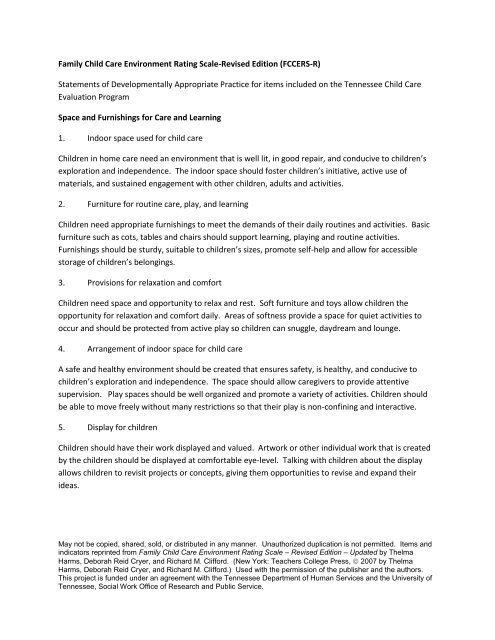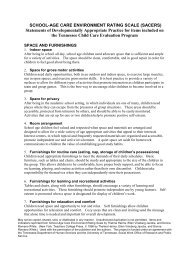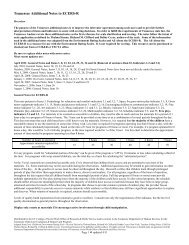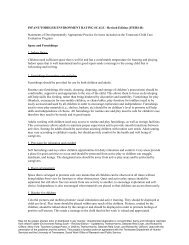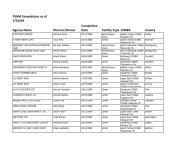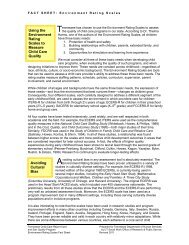Family Child Care Environment Rating Scale-Revised Edition ...
Family Child Care Environment Rating Scale-Revised Edition ...
Family Child Care Environment Rating Scale-Revised Edition ...
Create successful ePaper yourself
Turn your PDF publications into a flip-book with our unique Google optimized e-Paper software.
<strong>Family</strong> <strong>Child</strong> <strong>Care</strong> <strong>Environment</strong> <strong>Rating</strong> <strong>Scale</strong>-<strong>Revised</strong> <strong>Edition</strong> (FCCERS-R)<br />
Statements of Developmentally Appropriate Practice for items included on the Tennessee <strong>Child</strong> <strong>Care</strong><br />
Evaluation Program<br />
Space and Furnishings for <strong>Care</strong> and Learning<br />
1. Indoor space used for child care<br />
<strong>Child</strong>ren in home care need an environment that is well lit, in good repair, and conducive to children’s<br />
exploration and independence. The indoor space should foster children’s initiative, active use of<br />
materials, and sustained engagement with other children, adults and activities.<br />
2. Furniture for routine care, play, and learning<br />
<strong>Child</strong>ren need appropriate furnishings to meet the demands of their daily routines and activities. Basic<br />
furniture such as cots, tables and chairs should support learning, playing and routine activities.<br />
Furnishings should be sturdy, suitable to children’s sizes, promote self-help and allow for accessible<br />
storage of children’s belongings.<br />
3. Provisions for relaxation and comfort<br />
<strong>Child</strong>ren need space and opportunity to relax and rest. Soft furniture and toys allow children the<br />
opportunity for relaxation and comfort daily. Areas of softness provide a space for quiet activities to<br />
occur and should be protected from active play so children can snuggle, daydream and lounge.<br />
4. Arrangement of indoor space for child care<br />
A safe and healthy environment should be created that ensures safety, is healthy, and conducive to<br />
children’s exploration and independence. The space should allow caregivers to provide attentive<br />
supervision. Play spaces should be well organized and promote a variety of activities. <strong>Child</strong>ren should<br />
be able to move freely without many restrictions so that their play is non-confining and interactive.<br />
5. Display for children<br />
<strong>Child</strong>ren should have their work displayed and valued. Artwork or other individual work that is created<br />
by the children should be displayed at comfortable eye-level. Talking with children about the display<br />
allows children to revisit projects or concepts, giving them opportunities to revise and expand their<br />
ideas.<br />
May not be copied, shared, sold, or distributed in any manner. Unauthorized duplication is not permitted. Items and<br />
indicators reprinted from <strong>Family</strong> <strong>Child</strong> <strong>Care</strong> <strong>Environment</strong> <strong>Rating</strong> <strong>Scale</strong> – <strong>Revised</strong> <strong>Edition</strong> – Updated by Thelma<br />
Harms, Deborah Reid Cryer, and Richard M. Clifford. (New York: Teachers College Press, 2007 by Thelma<br />
Harms, Deborah Reid Cryer, and Richard M. Clifford.) Used with the permission of the publisher and the authors.<br />
This project is funded under an agreement with the Tennessee Department of Human Services and the University of<br />
Tennessee, Social Work Office of Research and Public Service.
6. Space for privacy<br />
Often children experience stress when exposed to prolonged group settings. Easily supervised places<br />
where children can escape from the pressures of group care promote positive self-esteem. Providing a<br />
child with opportunities, space, and time to be alone can contribute to positive classroom behavior.<br />
Personal <strong>Care</strong> Routines<br />
7. Greeting/departing<br />
Parents and children need a warm, welcoming, and pleasant atmosphere to make the daily greeting and<br />
departing routine a happy one. It is important that parents see and experience the environment in<br />
which children spend their day. Positive greetings help to promote the children's self-esteem and create<br />
a welcoming environment for parents. <strong>Care</strong>givers should be sensitive to separation anxiety by parents<br />
and children alike. <strong>Care</strong>givers should request information from parents upon arrival and freely share<br />
information about the children’s routines and activities while they are in their care.<br />
8. Nap/rest<br />
Nap and/or rest time should be appropriately scheduled and supervised for the children in the group.<br />
Each child should have his/her own personal place to rest. They should be helped to understand the<br />
importance of rest in promoting physical and emotional health. <strong>Care</strong>givers should stay alert to handle<br />
potential problems.<br />
9. Meals/snacks<br />
Meals and snacks that follow USDA guidelines contribute to the health of children and provide a model<br />
of good nutritional habits for life-long practice. Proper hand washing along with careful preparation of<br />
food teaches children proper hygiene and promotes sanitary conditions. Holding young children during<br />
bottle-feeding promotes nurturing relationships. Mealtimes provide an excellent opportunity for<br />
conversation and social interaction.<br />
10. Diapering/toileting<br />
Young children need appropriate supervision of the toileting process in order to care for basic needs and<br />
to teach the importance of good health habits. <strong>Care</strong>givers should maintain sanitary practices to prevent<br />
the spread of germs. Toileting practices promote self-help skills and provide an opportunity for one-onone<br />
interactions. The schedule for toileting should meet each child’s needs.<br />
May not be copied, shared, sold, or distributed in any manner. Unauthorized duplication is not permitted. Items and<br />
indicators reprinted from <strong>Family</strong> <strong>Child</strong> <strong>Care</strong> <strong>Environment</strong> <strong>Rating</strong> <strong>Scale</strong> – <strong>Revised</strong> <strong>Edition</strong> – Updated by Thelma<br />
Harms, Deborah Reid Cryer, and Richard M. Clifford. (New York: Teachers College Press, 2007 by Thelma<br />
Harms, Deborah Reid Cryer, and Richard M. Clifford.) Used with the permission of the publisher and the authors.<br />
This project is funded under an agreement with the Tennessee Department of Human Services and the University of<br />
Tennessee, Social Work Office of Research and Public Service.
11. Health practices<br />
Practicing preventive measures, such as washing hands after handling pets or wiping noses, helps<br />
children develop life-long healthy practices. Taking appropriate action when children are sick will<br />
minimize the spread of germs.<br />
12. Safety practices<br />
Protecting children through adequate supervision and minimizing hazards is critical for quality care.<br />
<strong>Care</strong>givers should anticipate potential safety problems and model safe practices. When children feel<br />
safe, they can focus on learning and appropriate experiences.<br />
Listening and Talking<br />
13. Helping children understand language<br />
All children, regardless of age, benefit from extensive exposure to meaningful language. <strong>Child</strong>ren’s early<br />
language experiences influence all areas of development. Language is best understood when modeled<br />
by caregivers who are attentive and talk to children in a warm, supportive manner with simple, exact<br />
words.<br />
14. Helping children use language<br />
<strong>Child</strong>ren use verbal and nonverbal language to communicate their needs. As children develop, their<br />
language becomes more distinguishable as words and phrases. When adults show interest in what the<br />
child is trying to communicate, children learn their words have meaning and are valued. Adults scaffold<br />
children’s language learning when they respond quickly, describe actions, introduce new words and ask<br />
questions.<br />
15. Using books<br />
The use of books is an important means of language development. Sufficient numbers of books should<br />
be accessible for both independent and group use. Experiences with books encourage continued<br />
interest in literacy. Book times should be engaging and interactive so that children eagerly anticipate<br />
reading. Literacy is further encouraged when books are kept in good repair, thus sending the message<br />
that books are a valued resource. <strong>Child</strong>ren should be allowed to choose from a wide variety of ageappropriate<br />
books.<br />
May not be copied, shared, sold, or distributed in any manner. Unauthorized duplication is not permitted. Items and<br />
indicators reprinted from <strong>Family</strong> <strong>Child</strong> <strong>Care</strong> <strong>Environment</strong> <strong>Rating</strong> <strong>Scale</strong> – <strong>Revised</strong> <strong>Edition</strong> – Updated by Thelma<br />
Harms, Deborah Reid Cryer, and Richard M. Clifford. (New York: Teachers College Press, 2007 by Thelma<br />
Harms, Deborah Reid Cryer, and Richard M. Clifford.) Used with the permission of the publisher and the authors.<br />
This project is funded under an agreement with the Tennessee Department of Human Services and the University of<br />
Tennessee, Social Work Office of Research and Public Service.
Activities<br />
16. Fine motor<br />
<strong>Child</strong>ren need a variety of developmentally-appropriate materials that promote small motor<br />
development. Materials should be accessible, in good repair, organized for play and support a variety of<br />
skill levels. Activities using these materials provide the foundation for school readiness skills such as<br />
handwriting and other small muscle tasks.<br />
17. Art<br />
<strong>Child</strong>ren benefit from appropriate art activities that are open-ended and process oriented. <strong>Child</strong>ren's<br />
art should be respected and appreciated as individual creative expression. Materials should be<br />
accessible as children are developmentally ready.<br />
18. Music and movement<br />
<strong>Child</strong>ren need access to a variety of music and movement materials that encourage self-expression.<br />
<strong>Child</strong>ren’s language needs are better met when recorded music is used for a specific purpose at limited<br />
times. Music opportunities promote cultural exposure and math concepts.<br />
19. Blocks<br />
Block play, with a variety of blocks and accessories, allows children the opportunity to explore spatial,<br />
mathematical, and role-play possibilities. Block play requires sufficient space in a protected area and<br />
time to expand on concepts and ideas.<br />
20. Dramatic play<br />
Dramatic play gives children the opportunity to discover an array of roles and responsibilities. It<br />
provides a vehicle through which they make sense of their world. Dramatic play is enhanced by space,<br />
time, props, materials, and supportive teachers.<br />
21. Math<br />
Math skills, when introduced through appropriate hands-on methods, form a foundation for school<br />
readiness and later academic success. Math skills can be taught effectively through routines, schedule,<br />
and play activities. A variety of materials that enhance math skills should be organized, in good repair<br />
and be freely accessible to children.<br />
May not be copied, shared, sold, or distributed in any manner. Unauthorized duplication is not permitted. Items and<br />
indicators reprinted from <strong>Family</strong> <strong>Child</strong> <strong>Care</strong> <strong>Environment</strong> <strong>Rating</strong> <strong>Scale</strong> – <strong>Revised</strong> <strong>Edition</strong> – Updated by Thelma<br />
Harms, Deborah Reid Cryer, and Richard M. Clifford. (New York: Teachers College Press, 2007 by Thelma<br />
Harms, Deborah Reid Cryer, and Richard M. Clifford.) Used with the permission of the publisher and the authors.<br />
This project is funded under an agreement with the Tennessee Department of Human Services and the University of<br />
Tennessee, Social Work Office of Research and Public Service.
22. Nature/science<br />
Science and nature activities and materials foster curiosity. When children have opportunities to<br />
experience the natural world, they learn respect and responsibility for the environment and living<br />
things. A variety of accessible science and nature materials promote observation skills and<br />
experimentation.<br />
23. Sand and water play<br />
Sand and water play gives children the opportunity for active exploration with sensory materials. The<br />
addition of interesting props extends the learning potential. Solitary sensory play can have a calming<br />
effect while small groups experience cooperative learning. Math and science concepts can be enhanced<br />
through sensory play.<br />
24. Promoting acceptance of diversity<br />
<strong>Child</strong>ren benefit from exposure to the diversity of people and cultures in positive ways through books,<br />
pictures, dolls and materials. Activities and classroom interactions are valuable resources as well. This<br />
exposure encourages respect and appreciation for others.<br />
25. Use of TV, video, and/or computer<br />
TV/video viewing and computer use tend to be passive in comparison to active involvement with<br />
materials and people. The use of each should be confined to subject material that is age-appropriate<br />
and related to curriculum content. Time limits encourage more active learning. Participation should not<br />
be required.<br />
26. Active physical play<br />
<strong>Child</strong>ren, including infants, need daily opportunities to exercise and practice gross motor skills.<br />
Opportunities for active play should be available both indoors and outdoors. All play equipment should<br />
be safe and effective monitoring should be implemented to teach children appropriate play behavior<br />
and to safeguard against accidents.<br />
May not be copied, shared, sold, or distributed in any manner. Unauthorized duplication is not permitted. Items and<br />
indicators reprinted from <strong>Family</strong> <strong>Child</strong> <strong>Care</strong> <strong>Environment</strong> <strong>Rating</strong> <strong>Scale</strong> – <strong>Revised</strong> <strong>Edition</strong> – Updated by Thelma<br />
Harms, Deborah Reid Cryer, and Richard M. Clifford. (New York: Teachers College Press, 2007 by Thelma<br />
Harms, Deborah Reid Cryer, and Richard M. Clifford.) Used with the permission of the publisher and the authors.<br />
This project is funded under an agreement with the Tennessee Department of Human Services and the University of<br />
Tennessee, Social Work Office of Research and Public Service.
Interaction<br />
27. Supervision of play and learning<br />
During activities, caregivers must balance the level of supervision and control based upon the ages,<br />
abilities, and individual needs of the children. Adequate supervision and awareness of the whole group<br />
is required to ensure children's health and safety. <strong>Care</strong>givers should provide materials that stimulate<br />
interests of the children. <strong>Care</strong>givers should intentionally engage with children at play.<br />
28. Provider-child interaction<br />
Nurturing and responsive caregivers promote the development of respect between children and adults.<br />
<strong>Child</strong>ren who trust adults to provide for their physical, psychological, and emotional needs develop a<br />
sense of self-worth.<br />
29. Discipline<br />
When rules are simple, consistent and fit the developmental levels of children this helps to foster a<br />
positive atmosphere. <strong>Environment</strong>s rich in materials with ample time to play impact how children<br />
behave in child care. Guiding children rather than confining for long periods of time is conducive to a<br />
well-rounded home. <strong>Child</strong>ren learn to get along with their peers and can often resolve issues<br />
independently.<br />
30. Interactions among children<br />
Self-regulation and positive relationships are essential life skills. <strong>Care</strong>givers should encourage children<br />
to develop pro-social behaviors by creating an environment that encourages empathy and respect.<br />
Modeling good social skills, providing opportunities for children to work and play together and to<br />
participate in group activities are ways caregivers can promote positive social relationships.<br />
Program Structure<br />
31. Schedule<br />
<strong>Child</strong>ren learn best in an environment where they know what to expect. A consistent schedule that<br />
offers ample time for indoor and outdoor play, smooth transitions between activities and a balance of<br />
child-initiated and teacher-directed activities promotes optimal learning. While children should<br />
experience a consistent routine, some flexibility is needed to allow for individual needs.<br />
May not be copied, shared, sold, or distributed in any manner. Unauthorized duplication is not permitted. Items and<br />
indicators reprinted from <strong>Family</strong> <strong>Child</strong> <strong>Care</strong> <strong>Environment</strong> <strong>Rating</strong> <strong>Scale</strong> – <strong>Revised</strong> <strong>Edition</strong> – Updated by Thelma<br />
Harms, Deborah Reid Cryer, and Richard M. Clifford. (New York: Teachers College Press, 2007 by Thelma<br />
Harms, Deborah Reid Cryer, and Richard M. Clifford.) Used with the permission of the publisher and the authors.<br />
This project is funded under an agreement with the Tennessee Department of Human Services and the University of<br />
Tennessee, Social Work Office of Research and Public Service.
32. Free play<br />
When children are permitted to select materials and companions, and manage play independently, they<br />
learn to make effective choices. When given opportunities to explore, children can follow their interests<br />
and work on skills they need to develop. <strong>Care</strong>giver involvement should be purposeful and responsive to<br />
children's needs.<br />
33. Group time<br />
Group times need to focus on recognizing and meeting individual needs and guiding children as they<br />
interact in small groups. Whole group activities should be kept to a minimum and limited to gatherings<br />
that follow the interests and involvement of the children.<br />
34. Provisions for children with disabilities<br />
<strong>Care</strong>givers able to serve children with special needs should make adjustments in space, schedule, and<br />
furnishings as needed. The child must be able to independently use the space and participate in<br />
activities. Meeting the needs of children with disabilities requires knowledge of routine care needs,<br />
developmental levels, individual assessments, and the integration of the children in ongoing activities. It<br />
also requires the involvement and establishment of a partnership between the parents and caregiver in<br />
setting attainable goals that will assist the child in reaching his/her full potential.<br />
May not be copied, shared, sold, or distributed in any manner. Unauthorized duplication is not permitted. Items and<br />
indicators reprinted from <strong>Family</strong> <strong>Child</strong> <strong>Care</strong> <strong>Environment</strong> <strong>Rating</strong> <strong>Scale</strong> – <strong>Revised</strong> <strong>Edition</strong> – Updated by Thelma<br />
Harms, Deborah Reid Cryer, and Richard M. Clifford. (New York: Teachers College Press, 2007 by Thelma<br />
Harms, Deborah Reid Cryer, and Richard M. Clifford.) Used with the permission of the publisher and the authors.<br />
This project is funded under an agreement with the Tennessee Department of Human Services and the University of<br />
Tennessee, Social Work Office of Research and Public Service.


